.
Don’t get clinical advice from social media.
.
.
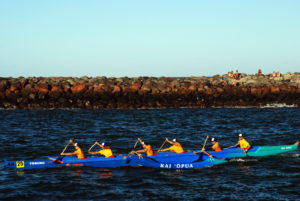
A typical outrigger canoe – the #3 paddler happens to be a PT I worked with on the Big Island. Aloha, Therron. Serious Paddler Dudes.
Last time Kate and I did a travel assignment in Hawaii, we joined the Molokai Canoe Club and paddled every week during our 6 months there. We were scheduled to practice 2 days per week, but the paddling really hinged on whether enough people showed up. To paddle an outrigger canoe, you need at least 4 people to have any fun at all – there are 6 seats, and it’s best if you have them all filled. Also, we couldn’t go at all without one of the steersmen, someone trained in steering the canoe – a steerswoman in this case. I haven’t shared enough about this experience. I try to avoid too much talk about Molokai on this site, because it’s a quiet and special place, and I’d like it to stay that way. But I was recently reflecting on my evenings in the canoes and at the canoe shack. They were special times. The kind of times only had when you step a bit outside your comfort zone.
The first thing you need to know is that the entire club is centered at “the canoe shack”. The shack is kind of a big deal. There’s several canoe clubs on the island, but the Molokai Canoe Club is the only one with a roofed structure. About 10 yards down the beach is another club, Club Va’a – they are the more competitive canoe club, but they don’t have a shack, just a couple storage containers. Molokai Canoe Club has been run by generation-after-generation of paddlers. When one generation of the Rawlins family ages out of the daily operations of running a canoe club, the next generation takes over. As with any respectable canoe club in Hawaii, they have a koa wood canoe. Here, with the time I have to write, and with your limited attention span, I cannot properly explain the great significance of the koa canoe. It is brought out for parades, big events, and only paddled during the most important races – the koa canoe is special, it’s spiritual. The major paddling events all have Koa divisions reserved only for clubs racing koa wood canoes.
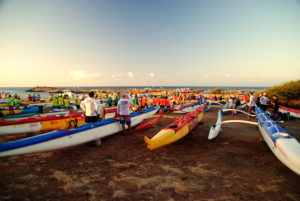
Paddlers getting ready for the 2014 Kaiwi Channel crossing.
Molokai is a mecca for Outrigger Canoeing. The biggest interisland races in Hawaii either start or finish on Molokai including the Kaiwi Channel Crossing – 40 miles of open ocean considered the world championship of Outrigger Canoe Races. Being first time paddlers, we were relegated to the recreational group, very recreational. Whether we had 6 people to fill all the seats in the canoe was always up to chance. Luckily, the recreational group got together on the same nights as the Uncles. “Uncle” and “Auntie” are respectful terms in Hawaii – best compared to using Ma’am or Sir. The Uncles at the canoe shack were legends back in their day. The local bar, Paddlers, has pictures on its walls of all the old teams that had won races and competed in the Kaiwi Channel Crossing – younger versions of the Uncles were littered through the pictures on the bar walls. Many of the Uncles are serious about their Hawaiian heritage and still take their paddling seriously, but they are more of a drinking club with a canoe problem. The canoeing is secondary to the comradery and social gathering that takes place every Tuesday and Thursday night after a solid paddle. Being with the recreational paddlers on the same nights, Kate and I got to know the Uncles well. We’d often hang out with them at the canoe shack after our paddle where someone showing up with dried octopus (taco in Hawaiian) or some fresh caught raw fish was commonplace. Frequently, we would combine numbers with The Uncles to make a full boat of 6 people – or to complete 2 boats of 6. Those evenings hanging at the shack with The Uncles were the most Hawaiian times I ever had. Even having worked in Hawaii 4 times previously, there were a couple of the Uncles that I couldn’t understand with their thick Pigeon English. Over the months, we built up hours and relationships with The Uncles, at some point I began to understand them all easily.

The Uncles share a celebratory shot before sailing their canoe 60 miles to the North Shore of Oahu.
On two occasions, the number of paddlers and water conditions were just right so that the Uncles wanted to go surf a canoe. On the first time Kate and I did this with them, conditions were perfect. We paddled out to some flat water beyond the wave break and enjoyed some beers from a cooler in the back of the canoe before surfing. We paddled into some waves a few feet tall breaking on the reef and let them lift the boat, carrying us in quite a ways. We paddled back out and repeated. Surfing the canoe was a much bigger rush and joy than I ever had surfing on a board.
The second time I went surfing with the Uncles, only myself and one other woman from the recreational group had shown up, but luckily there were four Uncles there who wanted to go surf some waves. In the boat that day were a couple of the local Molokai-grown Uncles, Uncle Clayton and Uncle Russell steering the boat; Sully, a transplant from the North Shore of Boston via Colorado who was a very serious paddler who had come to Molokai specifically to paddle with this group of guys; And Marty, a long-time Molokai transplant from the West Coast who must have been completely nuts as a younger guy, because all the local-Uncles respected him. These guys have all paddled together for years, making channel crossings between island and continuing to sail canoes great distances in races throughout the Hawaiian chain. I was in good hands that evening.
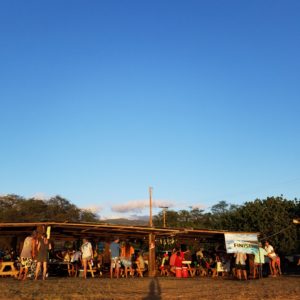
Closing out the canoe season with a final race followed by a full afternoon party at the canoe shack.
We paddled out in a channel on the left of the waves past the sets of big waves coming in and breaking on the reef – much bigger this time around, perhaps 6 or 7 foot waves. We made the big righthand U-turn to align the incoming waves behind us and paddled like crazy, there was a lull in the surf and we failed to catch any wave. We repeated our moves – made another righthand turn, paddled back out past the big waves and once again made our approach. Again, nothing. We repeated this one more time, again failing to catch a wave. We rested and decided on one last attempt. As we paddled out the fourth time, huge waves rolled past us – 10 or 12ft? We made our turn into the set between two of these huge waves. Being tired from the previous attempts, we didn’t get enough speed and ended up surfing IN the wave instead of ON the wave. The boat filled with water and the 6 of us were left sitting ducks with the walls of the canoe submerged underwater. We remained in our seats, water level at our waists and paddled like crazy with every ounce of energy to avoid the next oncoming waves. Somehow, we got out of the path of the breaking waves, back to the deeper water and had to get out of the boat to dump the water out. This dumping maneuver, rolling the canoe onto its side, got about half the water out of the boat and got the top of the canoe up out of the ocean – the rest of the water would have to come out through frantic bailing using hands, paddles, and two 1/2 milk jugs that had come with us for this exact purpose. As we all exhausted from swimming and bailing, someone noticed we had drifted back into the break. Another 10ft set was approaching off the right side of the canoe and it was time to GO! Everyone scrambled to get out of the water, into our seats, and paddle like our lives depended on it to get out of there. Maybe our lives did depend on it. We paddled like crazy and as the big set rolled in, our boat was gently lifted and dropped off the edge of the first wave as we scooted out from its path. I continued to bail the remaining water as the others paddled our soggy canoe and crew back to shore. I later learned that if that set of waves had caught us, we would hardly have been the first canoe to sink on that reef.
We skipped drinks and snacks (pupus) after that particular paddle. But out there, a half mile off shore, swimming around a sinking boat in a bad situation, I had a memorable experience with the Uncles. It wasn’t the kind of situation you could (or would ever want to) manufacture, but for me it was so unique. This was hardly the Uncles first time in that situation, but it was an experience I will remember forever.
The canoe shack was special, and I will remember it fondly. From sending racers off to open ocean races, to the big bash at the end of the canoe season, to near-catastrophe on the reef, to the simple evenings with the Uncles sharing pupus and Natty Light – the canoe shack left me with some of my favorite memories that leave me yearning for a return to Hawaii. Someday we’ll get back, some day. If you ever make it to Hawaii, join a local canoe club.
A quick video I shot one night out on the water paddling:

A clearly typical Boston Sunset
Join me for a run in Boston this Wednesday. The run will be around 5 miles and at 6 AM sharp. I hope to be back to the convention center at 7.
We will leave from the front of the convention center on Summer St and head through Downtown Crossing to Boston Common and the Public Garden, past the ORIGINAL Cheers to run along a stretch of the Charles River by the Esplanade and Hatch Shell. We will run past the Museum of Science, City Hall, and Quincy Market on our return to the conference center.
I’m from Boston originally, so I’m thrilled to be back running in the city – particularly along the Charles where I ran the majority of my miles when I was just beginning to run – I love that dirty water! I should be able to keep us pretty close to the intended path, but if you’ve looked at a map of Boston, I think you’ll understand if we go a tiny bit astray. It’ll be an adventure!
I’m currently training for the Reykjavik Marathon which I am running with Challenge Aspen, a nonprofit that provides adaptive outdoor recreation for people with disabilities of all kinds – skiing and snowboarding in the winter, and a huge variety of activities in the summer. Please consider a $10 donation to Challenge Aspen: bit.ly/2pymexC
Join me! It will be a fun way to see a big chunk of the city on foot!
Update: A great run! Thanks to everyone who joined. I’ve shared some pictures below.

Samuel Adams statue in front of Quincy Market. The ocean front was at this location in the past. Fanuel Hall was Boston’s version of Ellis Island.
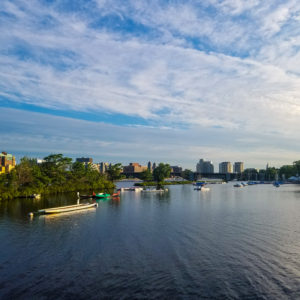
Love this dirty water. The Charles Rivah.

Boston City Hall
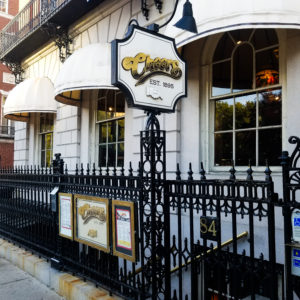
The ORIGINAL Cheers. The actual pub the TV series Cheers was based on. 5,000 points if you know the name of this pub before they recently changed it to Cheers.

The Hatch Shell and Esplanade
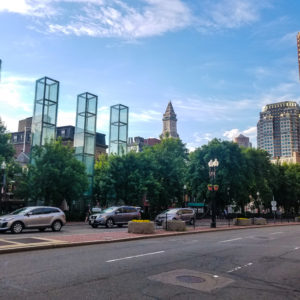
The Holocaust Memorial and the old State House building peeking out.
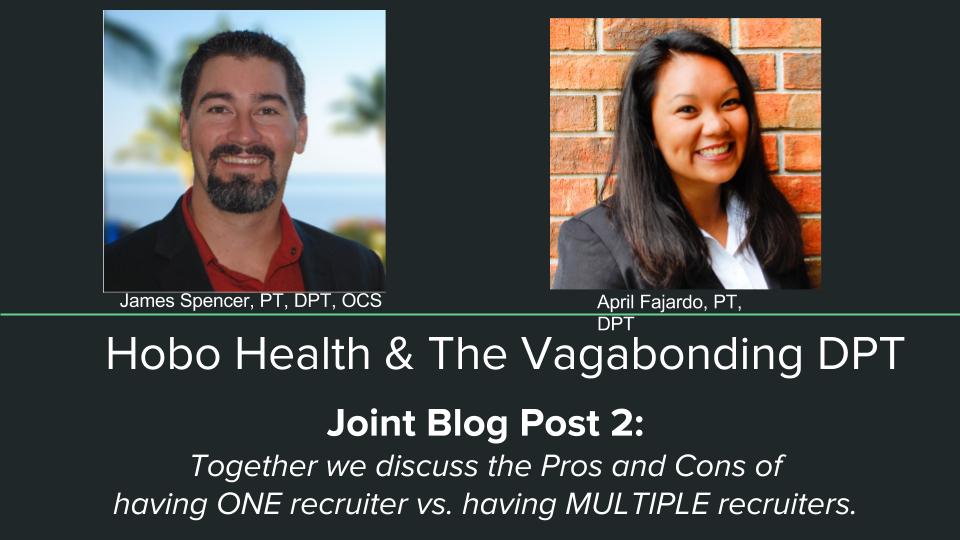 Introduction
IntroductionHoboHealth:
When I first started traveling, I worked with just one company, I had steady health benefits, I would accumulate PTO, and I even got a free wifi printer as a loyalty bonus. The printer was too big to travel with, but I still use it when I have it with me. The company I worked with initially has big name, and they were always able to find me a job. But, when I started looking around, I realized the deal I was getting might not be as good as I thought. Other companies were offering me as much as $200 more per week for similar jobs and seemed a lot more attentive to my needs. $200, that’s one wifi printer per week! That started me down a path of searching with multiple companies about 7 or 8 years ago.
The Vagabonding DPT:
I started traveling about 2 years ago as a new grad. I was fortunate to have a Travel PT mentor who set me up with my current recruiter. Yes, that’s singular. I have one recruiter. I know that the majority have multiple recruiters, but for now, having one recruiter has helped me build my career as a physical therapist. My recruiter is fully aware of my abilities, professional goals, minimum pay rate, and setting preferences. He’s submitted me for positions that I may not “qualify” for (i.e a requirement of 5+ years for a job assignment) because he was confident in my skills and that the position would be a perfect fit for me. Even as a new graduate with my first assignment, I’ve stood firm on negotiation of time off as well as pay rates. I got exactly what I wanted because I had a recruiter who was willing to negotiate those terms on my behalf.
HoboHealth:
Compare pay rates between companies. It becomes clear very quickly whether what you have been making is competitive with other companies’ rates or not. Knowing what other companies are able to pay you in a given area can be a great negotiating tool if you do decide to stay with just one company.
Different companies have different jobs. You will see many of the same jobs posted across most agencies – the jobs that are the same across agencies are all listed on databases that many facilities contract with to fill their jobs. The databases sell subscriptions to the staffing agencies to have access to their jobs (the databases also charge 3-4% of the total contract price to the recruiters). To beat this system, agencies have gone out of their way to make contracts to exclusively staff particular facilities. So, it is possible that you can’t find a job in a particular area because you aren’t looking with the agency that has an exclusive contract with a facility in the area. Also, some agencies rely solely on what comes across the databases; Other companies are willing to call around for you. All recruiters will say they are willing to canvas an area for you, but less will actually do it (the smaller agencies tend to be more willing to put in the footwork of tracking down novel contracts). Broadening your agencies, may open up additional options.
The Vagabonding DPT:
Each travel company provides different perks the more time you spend with them. The benefits listed below are solely representative of one company:
Paid Time Off: My company provides paid time off for 40 hours after working 2,080 hours and 1 year with them. A travel therapist would be free to cash out that PTO to fill any requested time off during an assignment or in between assignments. From that point thereinafter, you accrue some PTO for every hour you work.
New Grad Bonus: A new grad who works 3 consecutive contracts with this company will earn a $1,000 bonus.
Continuing Education Bonus: When you’ve stayed with this company, you receive $400 of continuing education credit valid also for conferences such as Combined Sections Meeting or NEXT.
Less Paperwork: Every company has a set of protocols that they must follow to be compliant with TJC including BLS certificate, licensing, NPI number, vaccinations, physical exams, TB tests, drug screen and physical examination. In addition, each company will have a mound of paperwork in regards to the company’s policies and procedures about expectations, benefits, clinical competency, etc.
Staying with one company allows you to focus on what you need: less paperwork and more time to invest in your passions and interests.
Health Insurance: If you choose to go with one company and choose to go with their health insurance, you won’t have to worry about switching health insurance companies. Travel PT companies will typically allow you a 30 day grace period in which you will be covered by the company while you’re between assignments.
Consistency: Some larger Travel PT companies will bounce you around with various recruiters who manage a particularly region. If this is the case, then you will have to take the time to let each recruiter know your preferences and want-list.
HoboHealth:
The obvious downsides to working with multiple agencies are the benefits you don’t get for being loyal to one agency and the extra paperwork you do get – as April mentioned above.
If you do work with multiple companies, remember this cardinal rule: “You take a particular job with whichever agency offers it to you first.” Meaning, you can’t take an assignment offered by one agency, and tell a different agency about it to try to get a higher pay rate. Things can get sticky fast.
It takes some management to work with multiple companies. At one time, I was searching with 6 or 7 different agencies. One job came up and they had received my resume from multiple different agencies, each claiming I was “their guy”. While I went with the first agency to present the job to me (the only agency who had permission to submit me for the assignment), another agency bullied the facility into only accepting my interview through them. I was unable to go with the agency I liked best and who had presented me the assignment first. It was embarrassing and it’s why I now limit my searches to 2 or 3 agencies. When you are working with multiple agencies, you have to be clear that you need to be contacted before being submitted to a job, otherwise you may end up in my situation with companies bickering over ownership of you with the facility – it’s embarrassing and a good way to blow the interview before you even have it.
The Vagabonding DPT:
As James mentioned above, working with one company requires much trust in one person to provide you with the best pay rate, location, and setting. By doing so, you may limit your options for future possibilities. You must trust that your recruiter is negotiating the terms of your contract to the best of his/her ability to provide you with the best overall package. To decrease this, you could also ask other Travel Therapists about their pay rate for that setting in that specific region.
The same facility may be working with several travel recruiting companies to fill a need. So when you work for multiple companies, you may be offered the same position via two different companies which can actually work against you. In the end, you may not end up with the assignment.
We present you with the advantages/disadvantages to assist you in making the best informed decision for your travel career path. We’ve each done our research to negotiate our contracts. Stay informed and ask around.
This is the second blog HoboHealth and The Vagabonding DPT have done together, you can link here to our first blog together about whether or not to travel as a new grad.
Check out our websites: www.hobohealth.com and www.thevagabondingDPT.org. Follow us on Twitter @HoboHealth and @AprilFajardoDPT. Finally, follow our Facebook Pages to keep up on our latest blogs and what/where we’re up to: HoboHealth and The Vagabonding DPT

James of HoboHealth worked in private practice before going into traveling PT and believes gaining professional experience is the right move to make before traveling. April of The Vagabonding DPT has had professional success and happiness through becoming a traveler immediately as a new grad. These two traveling Doctors of Physical Therapy from different personal and professional backgrounds have connected to provide you diverse perspectives on travel PT. This is their first blog post together of a series of topics.
What are the advantages of being a New Grad PT vs. being an Experienced PT then going into Travel PT?
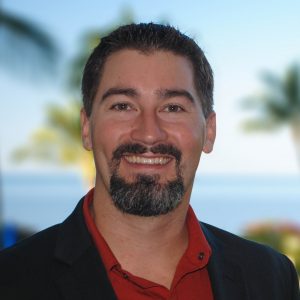 HoboHealth:
HoboHealth:
Professional Experience – I only worked for six months between graduation and starting as a traveling PT. The brief time I worked in private practice before traveling did a lot to shape who I am as a clinician today. Getting just a little bit of experience as a clinician allowed me to become grounded in a healthy work environment before setting out into the less predictable and less stable world of traveling.
Personal Marketability – I believe the little bit of experience I had in private practice prior to traveling gave me a leg-up on other candidates looking at the same jobs. My first traveling job was (primarily) outpatient in a community hospital outside of Boston with other therapists around to help continue my mentorship and growth. Without a little experience, I don’t believe they would have taken on the risk of hiring a near-new grad. Six months in private practice, followed by 10 months at my first travel assignment with strong mentorship set me up for 10 years of positive traveling assignments. Bottomline, if you get a little experience before travel, better employment opportunities are available to you as a traveler.
Vagabonding DPT:
My life was as compact as possible. I already had sold all my furniture and everything I owned fit into my Honda Civic. I was as mobile as I ever would be. If there was any opportunity to travel and explore, now was my moment. I had just spent my 3rd year completing my clinical rotations in Oklahoma City, OK; Salt Lake City, UT; Springfield, MO; and Dallas, TX. I was moving about every couple of months. In essence, my clinical internships provided me the opportunity to live the life of a travel DPT as a student. I was used to learning at a rapid rate and had to learn to adjust to a new city and clinic every few months. Because of this, It was quite an easy transition to go from a DPT student on clinical rotations to a DPT on the road for work.
You have “less” responsibility. As one begins to settle into their career and life (in general), the natural progression is to get settled into a specific location, get married, buy a house, have children or furry kids, and/or take care of ill, elderly parents. Although I think it is absolutely possible to travel with all the aforementioned circumstances, these factors require far more extensive benefit/cost analysis. For myself, I wasn’t married, I didn’t have a house, nor did I have children. So I made the personal decision to take the plunge straight into travel PT for further domestic exploration and adventures!
Money
Although I believe that this shouldn’t be your primary reason for going into traveling therapy. It definitely doesn’t hurt. Students are coming out with a tremendous amount of debt and this is definitely a great way to pay down those student loans.
What are the disadvantages of being a New Grad PT vs. being an Experienced PT then going into Travel PT?
HoboHealth:
When I first thought about this question, my gut reaction was, “There’s no disadvantage! What could be wrong with having more experience going into a job?” …but then I thought of the hardest day of my PT career – the day I had to quit my first job. The day I told my mentor and friend that I wouldn’t be able to work for him anymore was a really stressful day. Quitting a job, especially one that you like, is hard. I can see how someone with the intention to travel could go get a steady job and never end up leaving it. While I do believe strongly in getting experience before traveling, I can see how you risk getting “stuck” in a permanent job. I remember the phrase one of my professors told me to make quitting professional and simple, “It’s an opportunity I can’t pass up.” Remember that phrase, it’s a good one.
Also, the traveling lifestyle is only available to those in the right life situations to have the flexibility to take short-term contracts. Sometimes you have to strike while the iron is hot – waiting to take a permanent job, get several months of experience, and then quitting can shift you into a phase of life where the idea of travel isn’t as easy as it once was. New family obligations, meeting a significant other, and simple logistics like year-long rental leases can obstruct your path to the open road.
Vagabonding DPT:
Mentorship:
Off the bat, one’s initial thought may be the lack of mentorship. There are some travel companies that may market mentorship opportunities. I challenge you to ask them what exactly this looks like. Just being in the same clinic as other physical therapists does not constitute as mentorship. This can be countered by building an army of mentors while being a student. Based on my interests, I’ve inadvertently built an army of specialists from Neurologic PT to Global Health to Nonprofit Leadership.
Mentorship does not have to be limited to our profession. There is something to learn from everyone. Quite frankly, our patients become our first mentors. If you learn to listen intently, they will lead you to the answer. In addition, a firm understanding of other disciplines such as occupational therapy and speech & language pathology can help us maximize our role with a focus on patient-centered rehabilitative care.
Lack of Experience:
James touched upon this and it is true. There will be some jobs that will require that you have more experience than what you have had. However, I secured my second job assignment by highlighting my strengths and experiences in that setting. I applied for a position in inpatient rehabilitation that required 5 years of experience. So during my phone interview, I discussed my experience. I worked for two years as a PT aide in outpatient PT, then did an additional two years as a rehab aide prior to even applying for physical therapy. I also completed two clinical rotations in inpatient rehabilitation. I felt I was more than qualified for the position at hand. I’m glad that the rehabilitation manager was pleased with my response as well because she essentially hired me for the position. I’ve extended my contract since then.
Being a traveler can isolate you from the typical learning and professional development paths that may be available in more traditional PT careers. What have you done or do you plan to do to continue your professional development?
HoboHealth:
Board Specialty
Shortly after completing my transitional-DPT, I soon felt ready to pursue my Orthopaedic Clinical Specialty (OCS). I spent more than a year reading every piece of ortho research I could get my hands on and reading a couple comprehensive ortho books cover-to-cover. The constant studying kept me focused on a fixed goal for quite some time. Specialties through ABPTS are available in variety of practice areas. A couple supervisors on travel assignments have told me they hired me specifically because of my board specialist certification. In total, my tDPT and OCS combined filled the first 4 years of my professional life with a structured, focused learning path.
Some universities are offering post-doctoral learning paths that culminate in sitting for (and hopefully passing) the specialist exams. My alma mater, Northeastern University, offers a Certificate of Advanced Study in Orthopedics. Essentially, you take 5 online classes focused on advanced orthopedic practice, earn college credits, and become more prepared for the OCS exam. Programs like this can help you keep a structured learning schedule that can otherwise so easily fall out of priority while working as a travel PT.
Certifications
Generally, I am skeptical of programs focused on one clinical belief system and the alphabet soup that comes along with them. Courses that all come from a single guru will help you dive deeply into a treatment strategy, but are typically lacking in variety outside of that one strategy. However, as a way to provide a structure for learning towards a final goal, they can be very useful. I currently am about to set out on earning my certification in Dry Needling. Over the next year, I have my learning laid out for me and a fixed goal to be certified in Dry Needling and Cupping by the end of 2017. There are some other great programs available that offer several courses on different topics culminating in a single certification – do be discerning, not all certs are created equal.
Vagabonding DPT:
With the constant change, rapid rate of learning, and high productive expectations expected as a Travel PT, you can get burnt out and/or apathetic as a PT. It is pivotal that you “Be fearless in the pursuit of what sets your soul on fire.” Since graduation, I have done exactly that through social media, leadership positions, national PT conferences, and continuing education courses.
Social Media
I didn’t understand Twitter. I didn’t get the point. However, a few years ago, I ran for the position of APTA Student Assembly Director of Communications and thought that I should get one in the event I got elected and had to manage one. I’ll be honest. I had no idea what I was doing. With the Twitter mentorship of Matt Debole, PT, DPT, OCS and Stephanie Weyrauch, PT, DPT, they opened up a world of passionate students and clinicians from all over the country and the world. I started utilizing pound signs…I mean hashtags and twitter handles in my tweets. A few years later, I had the pleasure of engaging with these professionals virtually and in person.
If you don’t have a twitter account, get one. The best way is to just dive in and follow a few hashtags such as #ChoosePT, #DPTstudent, #SolvePT, #FreshPT, #PTFam and/or #TravelPT, just to name a few.
Still don’t get it? Start one, follow me, then tag me @AprilFajardoPT in your first tweet! Be part of the conversation.
PT Conferences
National Conferences: Have you ever been to National Student Conclave, Combined Sections Meeting (CSM), or NEXT? It’s how the kids say, “lit?” Yesss, LIT!!!! Everyone comes to this conference to learn, but one of the most important aspects of these conferences is the opportunity to formulate connections. If you’ve been active on social media, meet some of those you follow on Twitter at one of these conferences. You get to attend a multitude of receptions based on your interests and involvement from Alumni events to Section events. The exhibit hall is equipped with the latest physical therapy gadgets and with recruiters from every corner of the US. The
International PT Conference: This coming year, I plan on attending the World Congress of Physical Therapy on July 2nd-4th in Capetown, South Africa. I look forward to the opportunity to learn from and engage with physiotherapists around the world. Sounds enticing, doesn’t it? Well, the early registration deadline is November 30th. Join me and check out their website at http://www.wcpt.org/congress.
Professional Leadership
I’ve been on the go as a traveler; however, I’ve stayed engaged through the pursuit of my passions in professional development, engagement, APTA membership, global health, and service. I currently serve as The Academy of Neurologic PT’s membership and public relations committee member, an Early Career Team committee member, and the PT Day of Service’s Global Affairs Chair. My role in all these leadership positions has been location independent. If I can do it, you can too! Not sure where to start? Fill out the APTA Volunteer Interest Pool at http://www.apta.org/VolunteerGroups/ or email the APTA Executive Director of the Section you want to get involved in at http://www.apta.org/Sections/.
Continuing Education Courses
Every state has a different set of requirements for continuing education courses. However, I’ve found that the most helpful courses have been those developed by a specific section of the APTA. I’ve taken a continuing education course on Parkinson’s Disease developed by the Academy of the Neurologic PT. Terry Ellis, PhD, PT, NCS of Boston University and Lee Dibble, PhD, PT of University of Utah taught the course through the integration of the evidence and its clinical application. So if there’s a specific topic you want to learn about, check out what courses are provided by the appropriate APTA section.
As pumpkins take over the world, traveling therapists begin to think about their next assignment that will last a good portion of this winter. Where do you want to be this winter?

Ocean, check. Mountains, check. Yeah, I could do San Diego. Does anybody know what San Diago means?
On the beach? On top of a snowy mountain? Somewhere exotic and outlandish? Are you going to hibernate, or are you going to thrive? I’ve got you covered, here are some of the best places I’ve been in the winter and other places I would love to go in the future.
I always wanted to do an assignment in San Diego, but somewhere along the way it fell off my list. It seems like it would be a great place to get a January tan. I know lots of people who have taken assignments throughout Southern California and absolutely love it there. Home care offers really good pay rates in SoCal if you’re willing to try out that setting. The only hitch to working in California is that getting a license can take 4 to 6 months, so get started now if it’s on your list.
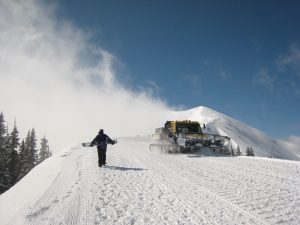
Pop Quiz:
Question: How does a snowboarder order a meal?
Answer: “Hey Bro, you gonna finish that?”
I love skiing, so I do the opposite of the snow birds. I love living in the mountains with skiing right outside my front door in the winter. There’s a lot of places to find jobs near skiing, but to actually live and work in a ski town is an experience that every avid skier (or snowboarder) should have. most hospitals in the Colorado Rockies hire directly (without staffing agencies) and you’ll need to pick up the phone and call or go check the hospital’s website for employment opportunities. You might have more luck around Salt Lake City which has more employment opportunities and all the world-class skiing you could dream of within a 30 minute drive. Wyoming and Montana offer more rural settings with great back country access and beautiful, pristine landscapes. New Hampshire, Vermont, and Maine all have quick access to big mountain skiing – some of the best skiers (and snowboarders) in the world come from New England – Bode Miller, Ted Ligety, Simon Dumont, Jeremy Jones. If you’ve wanted to see the Northeast and you’re a fan of winter sports, winter can be a great time with a lot of job opportunities and decent access even as far south as Boston.

Hawaii, idyllic for any traveller anytime of year. Plan ahead, lots of people want to go to Hawaii and jobs are competitive.
I love my time in Hawaii, but I am never here in the winter time due to my aforementioned affection for skiing. Although, the summit of Mauna Kea at over 13,000 ft does offer enough snow to ski on in depths of winter – so there’s that option. During the Hawaiian summer, the surf is more calm and better for swimming – the summer brings less rain too. But the winter is when Hawaii really displays its beauty. Migrating whales visit Hawaii by the thousands in the winter. The increased rain brings deep green colors to the hillsides that are brown and parched during the summer. And the surfing world gets together on Oahu’s North Shore to hold competitions on the best waves in the world during the winter months. If you want to go to Hawaii, you have to be flexible – a lot of people want to go there, so finding an assignment or getting your resume in ahead of other people can be hit or miss. I normally recommend making sure your recruiter presents jobs to you before letting them submit you. But Hawaii can be competitive enough that getting your name in first can be a real advantage – when it comes to Hawaii, you may consider giving your most trusted recruiter the green light to submit you to any job that fits your criteria.
Huh? Antarctica. Hang with me here for a minute. Our winter is the southern hemisphere’s summer. The University of Texas Medical Branch staffs the 3 US research stations in Antarctica with contract workers. Each year they look for, “Licensed Physical Therapists who have a strong clinical background and a taste for adventure.” I think both of those qualifications need to be strongly met. In a position where you may end up being a fairly solitary clinician with limited resources, you must know your stuff, and you have to be able to improvise with whatever is available to you. A “taste for adventure” states it lightly. I have heard this job is essentially like working on a submarine except that you get to go outside occasionally. My understanding is that you rarely get off base, and when you do, there is NOTHING (except hungry polar bears)… but, you’re in Antarctica and that is pretty cool. I have also heard about the “Race Around the World” – A 5K race in a loop around the South Pole – that’s just hilarious and awesome.
Did you know the US Virgin Islands are a part of FSBPT, the same body that all US states belong to for PT licensure? Oh yes. It is as easy to transfer your license to the Virgin Islands as it is to any other US state. There are jobs available in the Virgin Islands, it’s easy to transfer your license, and they are a short flight from anywhere east of the Mississippi. I’ve talked with a couple people who have worked there, and they’ve loved it.
On a side note, while FSBPT is in the conversation – if you are a traveling Physical Therapist or recruiter and you are unaware of the Physical Therapist Licensure Compact, educate yourself now. PT licenses between certain states will be reciprocal within the next two years – very exciting, make sure your state is included!
Don’t be limited by these 5 options. Choosing where to go as a traveling therapist is as personal choice as you could make. There’s all kinds of opportunities available in the Southeast and the Southwest – great, warm places in the winter. I’ve seen and heard wonderful things about Lake Havasu in Arizona and San Padre Island in Texas – I just know nothing about them, so they aren’t mentioned here. Why not make an adventure. Try finding an assignment in the Florida Keys. Don’t let any list limit you, go out and find the place YOU love, that’s what traveling therapy is all about.
I spoke with Jimmy McKay of PT PintCast about life as a Travel PT:
I Recently teamed up with Fusion Medical Staffing and several other Physical Therapists to write a piece educating providers and patients alike that Physical Therapists are the most well suited providers to visit FIRST for musculoskeletal conditions. Enjoy! #getPT1st
Fusion Medical Staffing – The Vibe – #GetPT1st
 What factors should you take into consideration for picking where you would like to go? A collaboration with Anders Group:
What factors should you take into consideration for picking where you would like to go? A collaboration with Anders Group:
http://www.andersgroup.org/2015/10/19/how-to-decide-where-to-travel/
The title is supposed to rhyme…. kinda.
Another collaboration with our friend The Gypsy Nurse in celebration of National Physical Therapy Month. Travelers live in a constant state of transition, the change to ICD-10 is just another simple tweak to our daily routines.